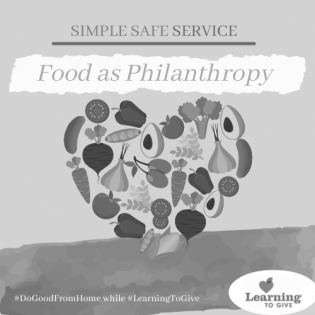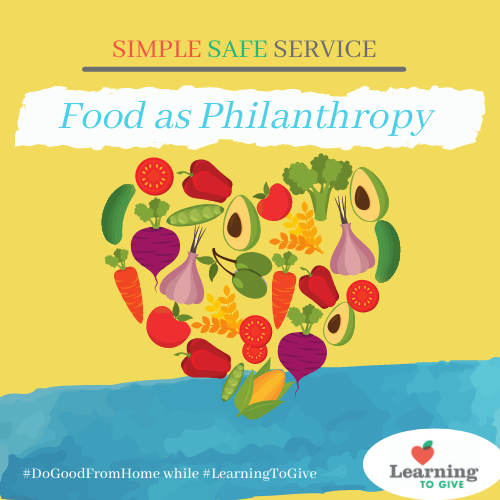Food as Philanthropy
Keywords:
Community
Emergency Response
Food
Needs Assessment
A Simple Safe Service project from home: Give food as a gift to express care and love or donate food to community members and local nonprofits.
SIMPLE SAFE SERVICE
Simple Safe Service activities are designed to spark generous action and conversations promoting the good of all.
Food has always been a gift we give from our hearts. When we visit family, friends, or community members, we often bring gifts of food, which is an expression of our time and talent - a one-of-a-kind gift. Whether we bring cookies to an elderly neighbor or donate canned goods to a shelter, food is a fundamental need and the first thing we think of in a crisis.
- Many people give gifts of food to show support, love, or connection. Think about how food brings people together. Talk about examples when food is the centerpiece of philanthropy, sharing our food-related time or talent or giving food. Read and reflect on this quote from Chef Guy Fieri:
"Cooking is all about people. Food is maybe the only universal thing that really has the power to bring everyone together. No matter what culture, everywhere around the world, people eat together."
- Think of someone in your community you'd like to support or know better. Is there a family or community member who is ill or displaced? Is there someone who has just had a baby or is celebrating something special? What about a new neighbor? Does your community have a food pantry that serves people who are food insecure?
- Find out more about their need and what will be helpful or bring you together. You could share a meal, something from your garden or pantry, or a sweet treat. Maybe you will simply invite someone to chat over food and you each bring your own.
- Ask about needs and protocols. Are there foods to avoid? How would it be best to deliver the food? Can the individuals receive the food themselves or should you deliver the food to a place in the community? The generous donation of food is a wonderful gift that is helpful in a difficult time, even if you don't see them in person.
- As a group or family, decide what you are going to do. Make a plan that reflects on the entire process from purchasing, preparing, and dropping off or meeting. Maybe you involve others in a food drive or plan a picnic in a park. If you are dropping off prepared food, use disposable serving dishes, if necessary. Follow your plan and make the connection.
- You may add items to your food gift, such as a flower from your garden or a homemade card. If you are working with a food pantry, ask whether the food collection drive could include gently used toys for children.
- Extension: Read about Jose`Andres, the man who "uses the power of food to nourish communities and strengthen economies through times of crisis and beyond."
- Take the next step: Invite others to help a family with a long-term need. Use a sign up system such as Meal Train to help organize community meal support.
Find more Simple Safe Servie activities.
Learning to Give ...
- educates youth about philanthropy, the civil society sector, and the importance of giving their time, talent and treasure for the common good (knowledge),
- equips youth by encouraging philanthropic behavior and experience (skills), and,
- empowers youth to take voluntary citizen action for the common good in their classrooms, lives and communities (behavior).

